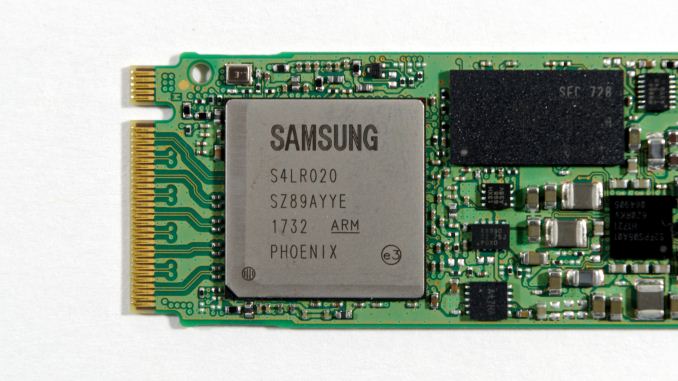The Samsung PM981 SSD Review (512GB, 1TB): Next Generation Controller And 3D NAND
by Billy Tallis on November 30, 2017 9:02 AM ESTConclusions
The Samsung PM981 looks poised to sit as a potential base for a 980 Evo equivalent in 2018. It offers a healthy generational improvement to performance due to the combination of a new controller and Samsung's new 64-layer 3D TLC NAND. The previous generation (PM961 for OEMs, 960 EVO for retail) was already the fastest TLC-based client SSD, and it outperforms many MLC-based SSDs. By improving on that level of performance, the PM981 has caught up to or surpassed the MLC-based 96x drives on many tests, setting new records not just for TLC-based drives but for client SSDs as a whole.
The Samsung PM981 offers performance that is more well-rounded than any other TLC-based SSD. The faster 1TB capacity is almost completely immune to the typical pitfalls of using TLC NAND; it is almost impossible for a real-world workload to trigger the kind of nasty slowdown that typically indicates a full SLC write cache or something else causing a lot of background work for the SSD controller.
The 512GB PM981 doesn't set records except for within its own product class, but it too is a meaningful improvement over its predecessors. The 512GB model doesn't handle heavy workloads quite as well as the larger model, but it still beats any other TLC-based option.
Both drives raise the bar for how well TLC SSDs should perform. On lighter workloads, they set a new standard that even MLC-based drives have trouble reaching. For almost everyone, the fact that the PM981 uses TLC NAND is no cause for concern because the performance defies the expectations for TLC SSDs. They are obviously great choices for OEMs to offer in high-performing notebook computers, depending on the power consumption, which we will test when our testing equipment is fixed.
Enthusiasts will have to wait until CES in January or some later event to hear about Samsung's next SSDs based on the PM981, which is likely to be called the 980 Evo if it follows previous naming conventions. These PM981 drives, if you can source them on the grey market, may be a reasonable choice for impatient system builders wanting to put the latest TLC into their systems today. As always though, OEM drives purchased on the grey market come with no warranty from the manufacturer and firmware updates may be hard to come by, so they aren't for everyone.











53 Comments
View All Comments
skavi - Monday, December 4, 2017 - link
Lol, tech isn't wine. If people aren't working to improve it, it won't get better.skavi - Monday, December 4, 2017 - link
Lol, tech isn't wine. If people aren't working to improve it, it won't get better.WorldWithoutMadness - Friday, December 1, 2017 - link
that and ram oligopoly. Almost reminded me of intel before ryzen.Drumsticks - Thursday, November 30, 2017 - link
I doubt we'll see 1TB 3D XPoint in an m.2 form factor until at least the second generation of XPoint. Power consumption looks too high; you'd probably have to severely limit performance to get into m.2, or you'd need a massive unrealistic heatsink.UltraWide - Thursday, November 30, 2017 - link
Yes, the people want to see 900p destroy these benchmarks!! :)romrunning - Thursday, November 30, 2017 - link
I would love to see the Optane 900p results included as well.peevee - Thursday, November 30, 2017 - link
Me too.mczak - Thursday, November 30, 2017 - link
I miss the power draw numbers.Drazick - Thursday, November 30, 2017 - link
I don't like those m.2 drives. Can't we have high bandwidth connection for 2.5 inch drives? It will have less thermal issues for desktop configurations.DanNeely - Thursday, November 30, 2017 - link
That's the barely gained any traction outside of enterprise U.2 connection.